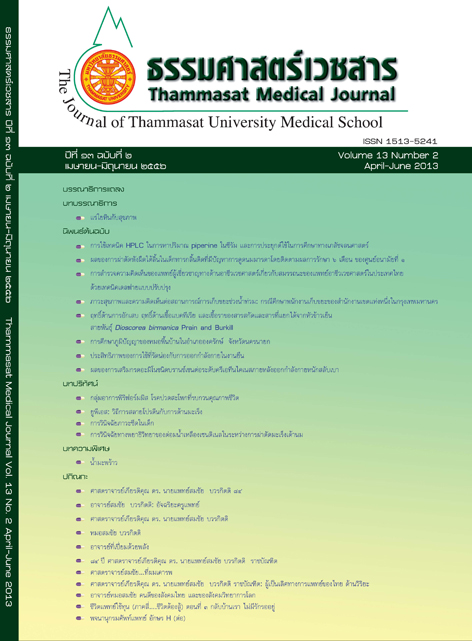Anti-inflammatory, antibacterial and antifungal activities of Dioscorea birmanica Prain and Burkill extract and its ingredients
Keywords:
หัวข้าวเย็น ชนิด Dioscorea birmanica, ฤทธิ์ต้านการอักเสบ, ฤทธิ์ต้านเชื้อจุลชีพ, Dioscorea birmanica Prain and Burkill, Anti-inflammation, Antimicrobial activityAbstract
Introduction: Hau-Khao-Yen (Dioscorea birmanica Prain and Burkill) is a herb that was used to treat inflammatorycondition, reduce pain, abscess and cancer, etc. The objective of this research was to investigate theanti-inflammatory, antibacterial and antifungal activities of D. birmanica Prain & Burkill extract (DBE)and its ingredients.
Method: Bioassay guided fractionation was used for isolating compounds. The structure elucidation of activeingredients was proven by thin layer chloromatography (TLC) and spectrophotometry techniques.Anti-inflammatory activity was test by inhibitory effect on PGE2 production as followed the method ofCopeland. Agar diffusion and minimum inhibitory concentration (MIC) was used for antibacterial andantifungal activities.
Result: Four fractions from DBE were isolated using vacuum liquid chromatography (VLC) with ordering polarityof solvents and were coded as DB-Fr1 to DB-Fr4, respectively. The results showed the chloroform :methanol (1:1) fraction of D. birmanica Prain & Burkill (DB-Fr4) showed the highest percentage of yield(50.02%,10.646 g.). All fractions showed anti-inflammatory activity by inhibitory effect on PGE2 production.The antifungal and antibacterial activities were also tested by disc diffusion method. The results showedthat the fraction DB-Fr2 (CHCL3), DB-Fr3 (CHCL3 : MeoH, 8:2) and DB-Fr1 (Hexane : CHCL3, 2:8)exhibited high inhibitory effect on PGE2 production (IC50 = 5.02 ± 0.31 μg/ml, 6.96 ± 0.04 μg/ml and11.04 ± 1.23 μg/ml respectively) (IC50 of indomethacin or positive control as 1 μg/ml). All of extracthad no antibacterial activity against gram negative bacteria such as Escherichia coli, Pseudomonasaeruginosa, Salmonella typhi, Shigella dysenteriae but showed less antibacterial against gram positivebacteria such as Staphylococcus aureus and Bacillus subtilis (clear zone diameter = 7-8 mm.) DB-Fr2-P1,DB-Fr2-P2 and DB-Fr4-P1 were isolated by bioassay guided fractionation and showed the highest inhibitoryeffect on PGE2 production (IC50= 4.80 ± 0.05, 10.18 ± 1.47 and 29.11 ± 1.15 μg/ml, respectively).For the antifungal activity, DB-Fr4-P1 showed the highest activity against Candida albicans (clear zone wasequal to 10 ± 0.17 mm. and MIC value as 12.5 μg/ml). It was compared with the standard antibioticssuch as Amphotericin B (MIC=1 μg/ml). It was considered as moderate antifungal activity againstC. albicans.
Discussion and Conclusion: It can conclude that the results on antiinflammatory and antimicrobial activities of Hua-Khao-Yen (Dioscorea birmanica) related with the local wisdom using as inflammatory condition such as abscess, cancer andvagina discharge.
Key words: Dioscorea birmanica Prain and Burkill, Anti-inflammation, Antimicrobial activity



